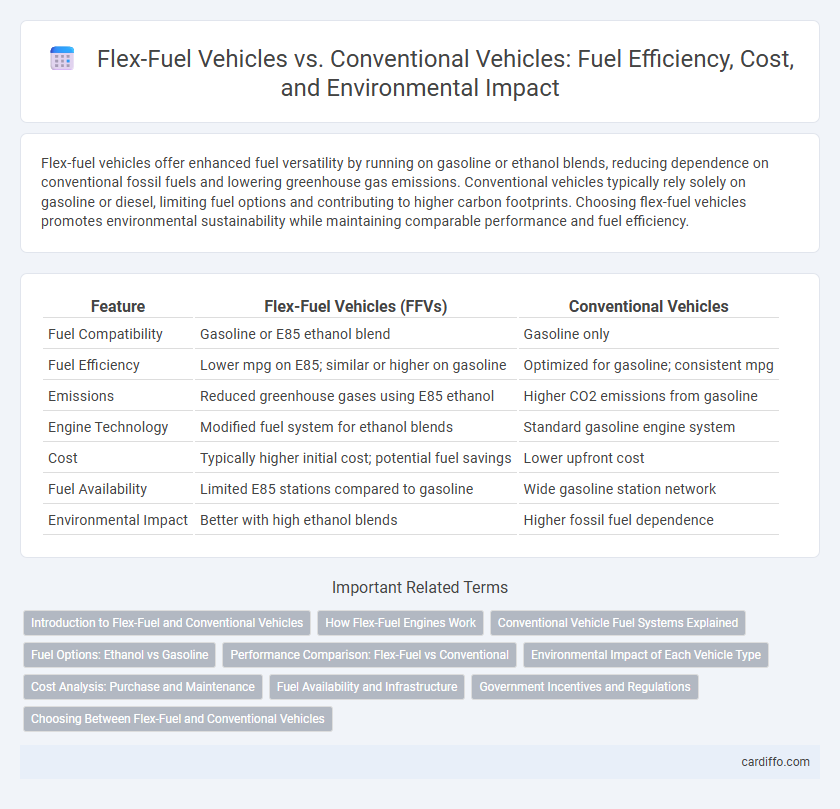Flex-fuel vehicles offer enhanced fuel versatility by running on gasoline or ethanol blends, reducing dependence on conventional fossil fuels and lowering greenhouse gas emissions. Conventional vehicles typically rely solely on gasoline or diesel, limiting fuel options and contributing to higher carbon footprints. Choosing flex-fuel vehicles promotes environmental sustainability while maintaining comparable performance and fuel efficiency.
Table of Comparison
| Feature | Flex-Fuel Vehicles (FFVs) | Conventional Vehicles |
|---|---|---|
| Fuel Compatibility | Gasoline or E85 ethanol blend | Gasoline only |
| Fuel Efficiency | Lower mpg on E85; similar or higher on gasoline | Optimized for gasoline; consistent mpg |
| Emissions | Reduced greenhouse gases using E85 ethanol | Higher CO2 emissions from gasoline |
| Engine Technology | Modified fuel system for ethanol blends | Standard gasoline engine system |
| Cost | Typically higher initial cost; potential fuel savings | Lower upfront cost |
| Fuel Availability | Limited E85 stations compared to gasoline | Wide gasoline station network |
| Environmental Impact | Better with high ethanol blends | Higher fossil fuel dependence |
Introduction to Flex-Fuel and Conventional Vehicles
Flex-fuel vehicles (FFVs) operate on a blend of gasoline and ethanol fuels, typically ranging from E10 to E85, allowing greater fuel flexibility and reduced greenhouse gas emissions. Conventional vehicles rely solely on gasoline, which limits fuel options and may result in higher carbon footprints compared to FFVs. The availability of FFVs enhances the use of renewable biofuels and supports energy diversification in transportation.
How Flex-Fuel Engines Work
Flex-fuel vehicles (FFVs) use specialized engines designed to run on gasoline or a blend of gasoline and ethanol, typically up to 85% ethanol (E85), utilizing sensors to detect fuel composition and adjust fuel injection and ignition timing accordingly. These engines feature modified fuel systems resistant to corrosion from ethanol and optimized compression ratios for efficient combustion of varying fuel mixtures. This adaptability enables FFVs to reduce greenhouse gas emissions and reliance on petroleum compared to conventional gasoline-only vehicles.
Conventional Vehicle Fuel Systems Explained
Conventional vehicles rely on fuel systems designed exclusively for gasoline or diesel, featuring components like fuel pumps, injectors, and filters optimized for these specific fuels. These systems operate under precise pressure and flow parameters to ensure efficient combustion and engine performance. Unlike flex-fuel vehicles, conventional systems lack the hardware and sensor adaptations needed to process ethanol-blended fuels, limiting their fuel compatibility.
Fuel Options: Ethanol vs Gasoline
Flex-fuel vehicles (FFVs) can operate on varying blends of ethanol and gasoline, primarily E85 (85% ethanol, 15% gasoline), offering flexibility and reduced greenhouse gas emissions compared to conventional vehicles that rely solely on gasoline. Ethanol, derived from renewable sources like corn or sugarcane, burns cleaner and reduces dependence on fossil fuels but typically provides lower energy content, resulting in slightly reduced fuel efficiency. Gasoline, a petroleum-based fuel, delivers higher energy density and engine performance but contributes to greater carbon emissions and environmental pollution.
Performance Comparison: Flex-Fuel vs Conventional
Flex-fuel vehicles (FFVs) offer versatile fuel options by running on ethanol blends like E85 or regular gasoline, impacting engine performance outcomes compared to conventional vehicles. While FFVs typically exhibit slightly reduced fuel economy due to ethanol's lower energy content, they can provide similar or enhanced horsepower and torque metrics when optimized for ethanol use. Conventional vehicles usually benefit from consistent performance and fuel efficiency with gasoline, but they lack the adaptability and potential renewable fuel benefits found in flex-fuel technology.
Environmental Impact of Each Vehicle Type
Flex-fuel vehicles (FFVs) offer reduced greenhouse gas emissions by running on ethanol blends like E85, which burn cleaner compared to conventional gasoline, lowering carbon monoxide and particulate matter. Conventional vehicles rely solely on petroleum-based fuels that emit higher levels of carbon dioxide and pollutants, contributing more significantly to air pollution and climate change. Lifecycle analysis indicates that FFVs operating on biofuels achieve a smaller carbon footprint due to renewable fuel sources and decreased fossil fuel dependency.
Cost Analysis: Purchase and Maintenance
Flex-fuel vehicles (FFVs) typically have a higher initial purchase price due to specialized fuel system components designed to handle ethanol blends like E85, but maintenance costs remain comparable to conventional vehicles since most parts are similar. Conventional vehicles generally cost less upfront and use standard gasoline, which can be cheaper or more stable in price than ethanol fuels, impacting overall fuel expenses. Evaluating total ownership cost requires factoring in fuel price volatility, availability of E85 stations, and potential incentives for FFVs that may offset the initial cost differential over time.
Fuel Availability and Infrastructure
Flex-fuel vehicles (FFVs) benefit from a growing network of fueling stations offering ethanol blends like E85, particularly in regions with strong biofuel policies such as the Midwest United States. In contrast, conventional vehicles rely primarily on gasoline, which has widespread availability across virtually all fueling stations globally, ensuring consistent access regardless of location. The expanding ethanol infrastructure supports FFVs' flexibility but still lags behind gasoline's dominant refueling convenience and coverage.
Government Incentives and Regulations
Government incentives for flex-fuel vehicles (FFVs) often include tax credits, rebates, and access to HOV lanes, encouraging adoption of ethanol-blended fuels like E85. Regulatory frameworks such as the Renewable Fuel Standard (RFS) mandate increased biofuel usage, benefiting FFVs by promoting market demand and fueling infrastructure expansion. Conventional vehicles, typically reliant on gasoline, receive fewer direct incentives and face stricter emissions regulations aimed at reducing environmental impact.
Choosing Between Flex-Fuel and Conventional Vehicles
Flex-fuel vehicles (FFVs) offer the flexibility to run on gasoline or ethanol blends such as E85, reducing reliance on fossil fuels and lowering greenhouse gas emissions by up to 25%. Conventional vehicles, while typically providing higher fuel economy with pure gasoline, lack compatibility with alternative fuels, limiting consumer options amid fluctuating fuel prices and environmental regulations. When choosing between FFVs and conventional vehicles, consider factors like fuel availability, environmental impact, driving habits, and long-term cost savings related to alternative fuel use.
Flex-Fuel Vehicles vs Conventional Vehicles Infographic

 cardiffo.com
cardiffo.com